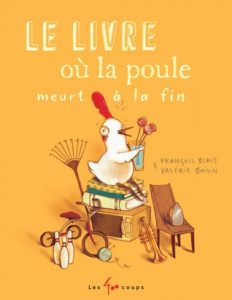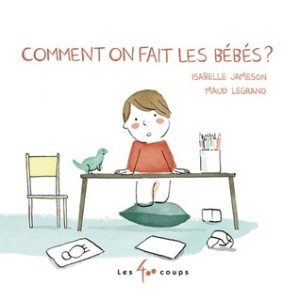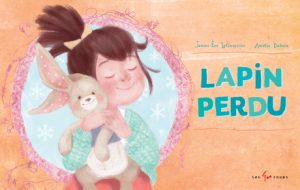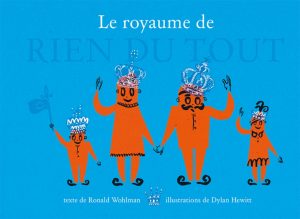 Throw away all your preconceptions of what picture books for children should look like or what trajectory they should follow, because you’re in for a real treat! This title had me laughing out loud the further into the story I got, at first with a chuckle at the premise that Catherine should spend whatever she likes because she won’t be around long enough to have to deal with the debts she incurs from her irresponsible spending habits – she has a point – and then as we made our way along the story, irrepressible laughter at Catherine’s unflappable practicality and unapologetic personality. I was reminded of Ariana Grande’s 7 rings throughout the entire book, in the best of ways.
Throw away all your preconceptions of what picture books for children should look like or what trajectory they should follow, because you’re in for a real treat! This title had me laughing out loud the further into the story I got, at first with a chuckle at the premise that Catherine should spend whatever she likes because she won’t be around long enough to have to deal with the debts she incurs from her irresponsible spending habits – she has a point – and then as we made our way along the story, irrepressible laughter at Catherine’s unflappable practicality and unapologetic personality. I was reminded of Ariana Grande’s 7 rings throughout the entire book, in the best of ways.
I happened upon this title recently and absolutely adored it (I was tempted to rip off a coworker’s Staff Pick sticker so I could put my own on it), for reasons I’m sure are obvious just looking at the cover: Le livre où la poule meurt à la fin by François Blais, illustrated by Valérie Boivin. I agree with this reviewer that the complete irreverence of the entire book towards the topic of death (normally treated as a taboo topic, though do take a look at how other authors have treated death in picture books) is actually quite refreshing, especially what with the bright colours used throughout and the flippant, very tongue-in-cheekily practical attitude Catherine – the chicken – herself has towards her fate.
Hilarious through and through, this alternate perspective on death and what one can do with the knowledge of our own impending doom is a complete delight. And if you’re into unexpected twists (it’s almost like a right-angle Freytag triangle of plot structure), you might also enjoy another book by the same author in the same grimace series: 752 lapins, same author & illustrator duo. There’s also this other review of both of these titles that I enjoyed especially for their discussion suggestions with the child if you’re reading to one.
Keep reading for more (slightly less audacious) French picture books!
In Lapin perdu; Lapin trouvé by Amélie Dubois, illustrated by Janou-Ève LeGuerrier, poor Annabelle has lost her doudou, her chouchou, her tout doux lapin Pinpin adoré and feels the hole in her life very sharply. Her parents try to find a replacement, but nothing can replace her doudou, her chouchou, her tout doux lapin Pinpin perdu – not a llama, not a penguin, not one of them will do! The rhyming and the tongue-twisting repetition of Annabelle’s insistence on her doudou, her chouchou, her tout doux lapin Pinpin makes for quite a fun read through, and even if that were all there was to the book, I would probably have been sold. But then Dubois & LeGuerrier go and use both sides of the book to tell the full story of lapin Pinpin’s journey as Pinpin is lost and then found. The only thing I found odd was that the two girls in the story never meet in the center, which left me a bit disappointed that the serendipitous event of having lost/found lapin Pinpin and then finding their way to each other to return Pinpin home did not also involve the beginning of a possible friendship.
The illustrations of Janou-Ève LeGuerrier work so beautifully with the text – the colours are all so gentle and her style of illustration so soft, allowing text and illustration to complement each other to wonderful effect.
 Next on the list is Comment on fait les bébés? by Isabelle Jameson, illustrated by Maud Legrand, which doesn’t quite go in the way you think it’ll go (whether your first thoughts turned to the stork or the biological explanation).
Next on the list is Comment on fait les bébés? by Isabelle Jameson, illustrated by Maud Legrand, which doesn’t quite go in the way you think it’ll go (whether your first thoughts turned to the stork or the biological explanation).
There are clues scattered throughout what the child in the story wants to know by asking their parents: “comment on fait les bébés?”, but you don’t notice it until the very end. The roundabout journey that simple question takes the parents on, though, is the real joy here. You can see the slightly panicked discussion taking place behind the scenes in the way the parents make eye contact with one another and give their explanation before backtracking or providing another one. I’ve never had to entertain this question, but I imagine this portrayal of what discussion might take place is somewhat true to life in that there are so many considerations to be had by the parents regarding how much to say, what version of events to give, whether there are more factors to consider than at first you might have thought, not wanting to misinform the child either.
The illustrations are simple but effective in conveying the various states of confusion and irritation, as well as the loss of words in which state the parents occasionally found themselves. All in all, great pairing between author & illustrator, and a cheeky end to all the effort.
Le royaume de rien du tout by Ronald Wohlman, illustrated by Dylan Hewitt, is admittedly a little longer than I think it should’ve been (and I have agreement on this by other readers as well), especially in the way the day part of the book was dragged out. It felt as though Wohlman tried to too thorough in driving the point home, given that there was dusk and night to go through as well. I would’ve been perfectly happy with just the day portion, shrunk down a few pages. But the reason I’m including it in my list is because 1) look at that cover: the illustrations are A+, and 2) the pacing and storytelling was actually great until it dragged on too long – it’s cheeky and places traps for the reader that I admit I fell into (making snide remarks to fellow readers as we made our way through, only to be shown up by the author in having anticipated my snide remarks). This royal family lives on a planet where there is nothing – nothing at all (though I do see the ground, the sun and the sky, so perhaps not strictly speaking nothing…) – and we learn about all the games they play and ways they keep themselves amused, as well as the ways in which they show each other they love and care about one another without any physical gifts to offer. All in all, heartwarming and fun, but just a touch too long… in a way like this post.


I just put a hold on Le livre où la poule meurt à la fin, because I found out it meant “The book where the chicken dies at the end” :)!